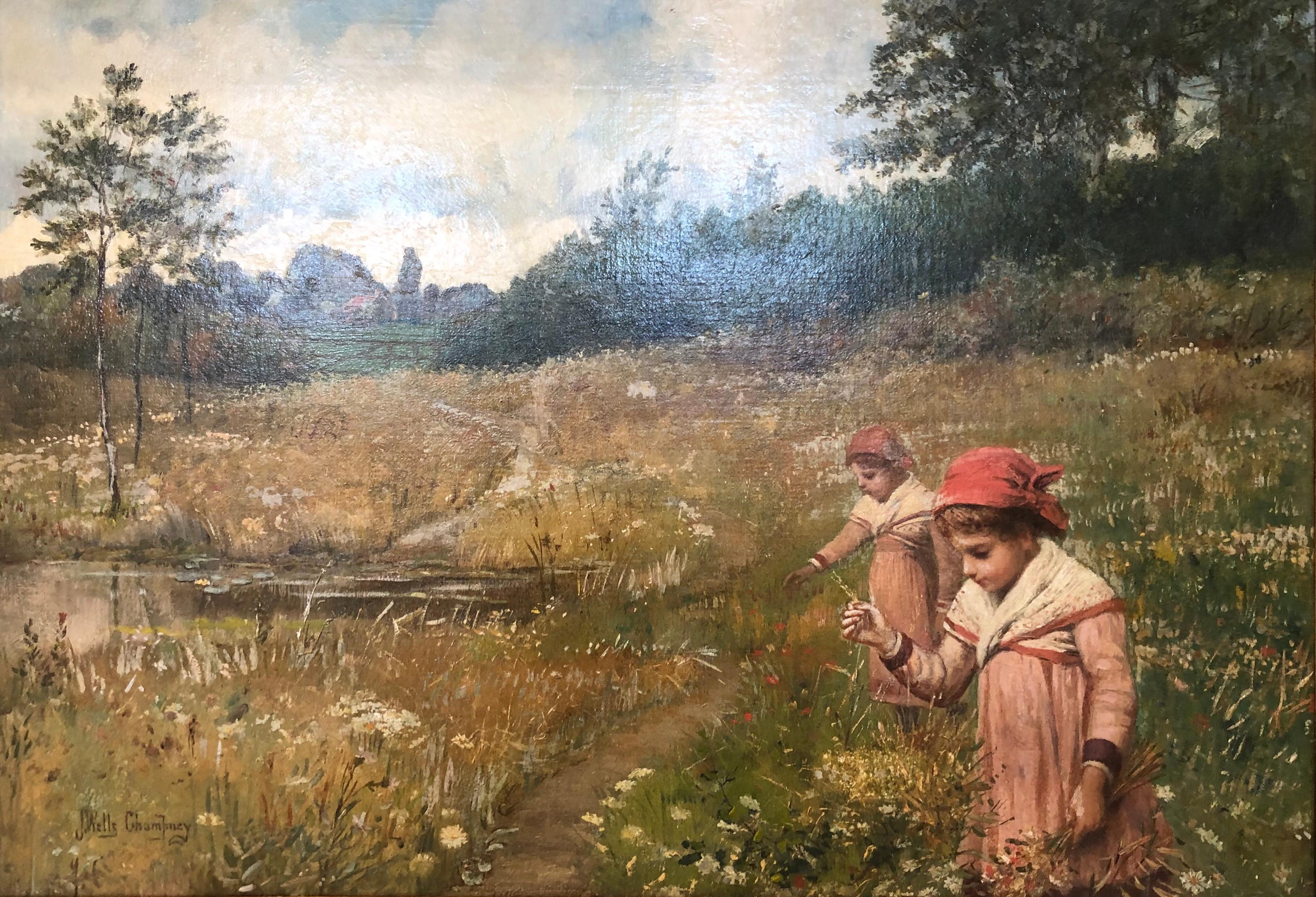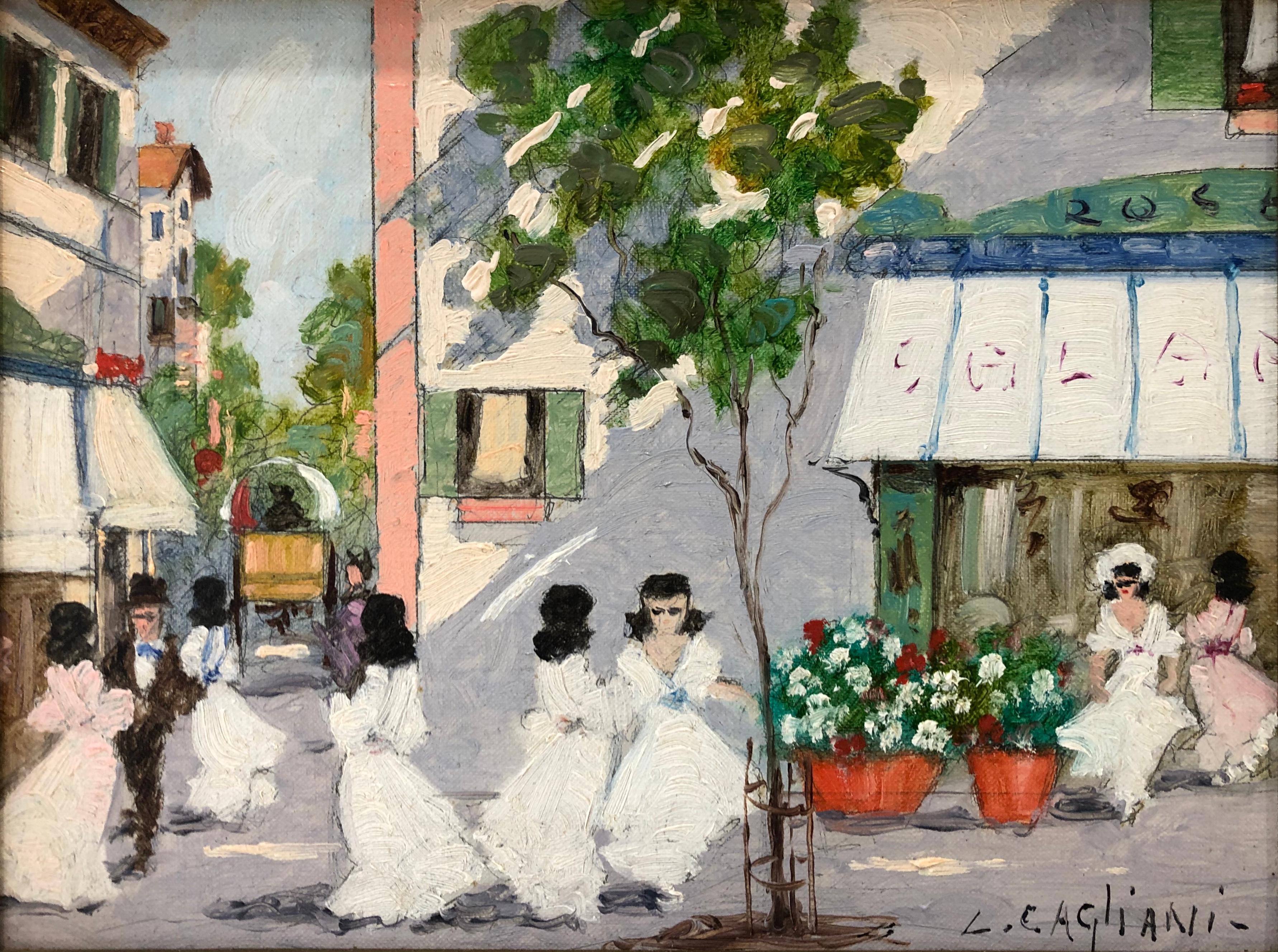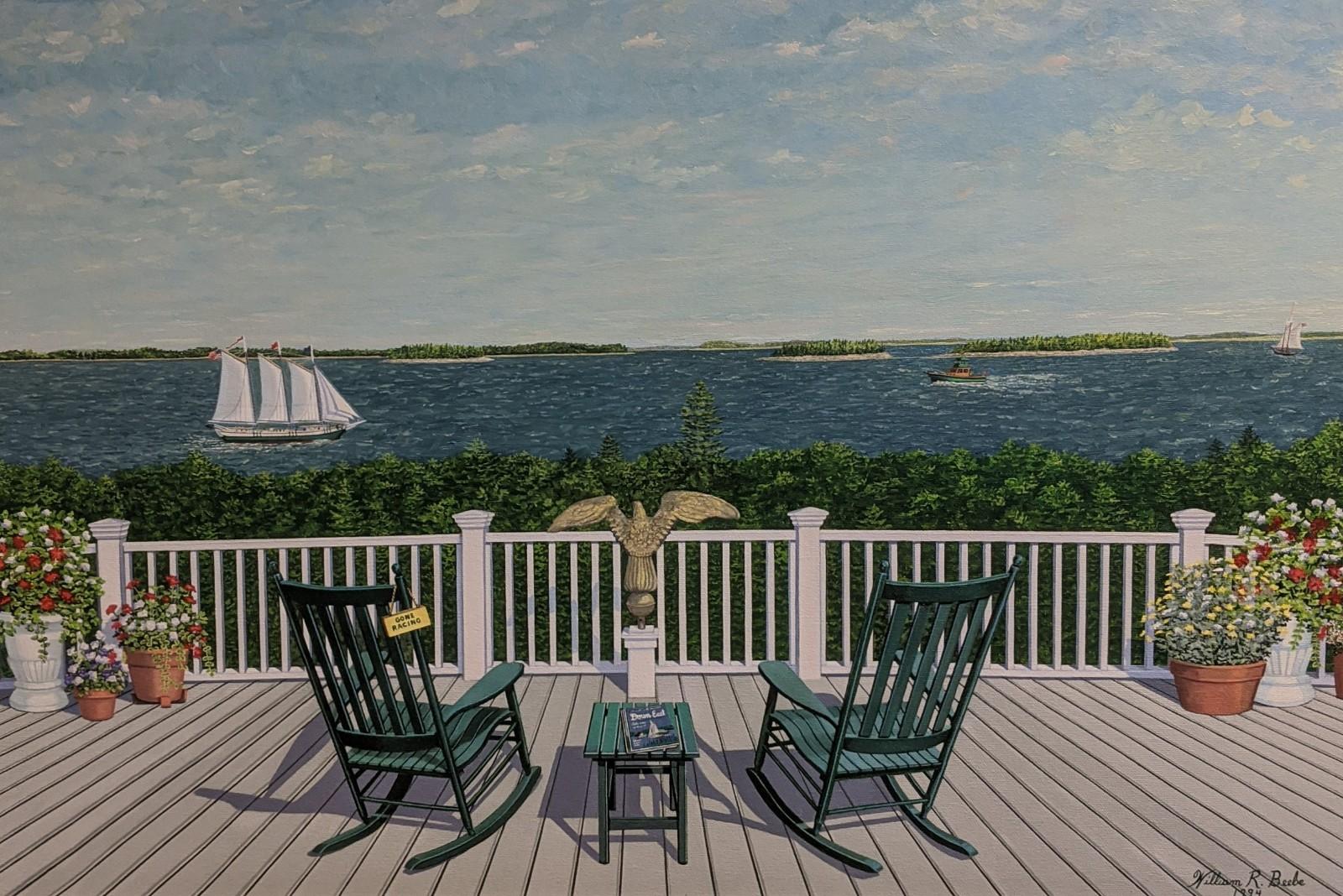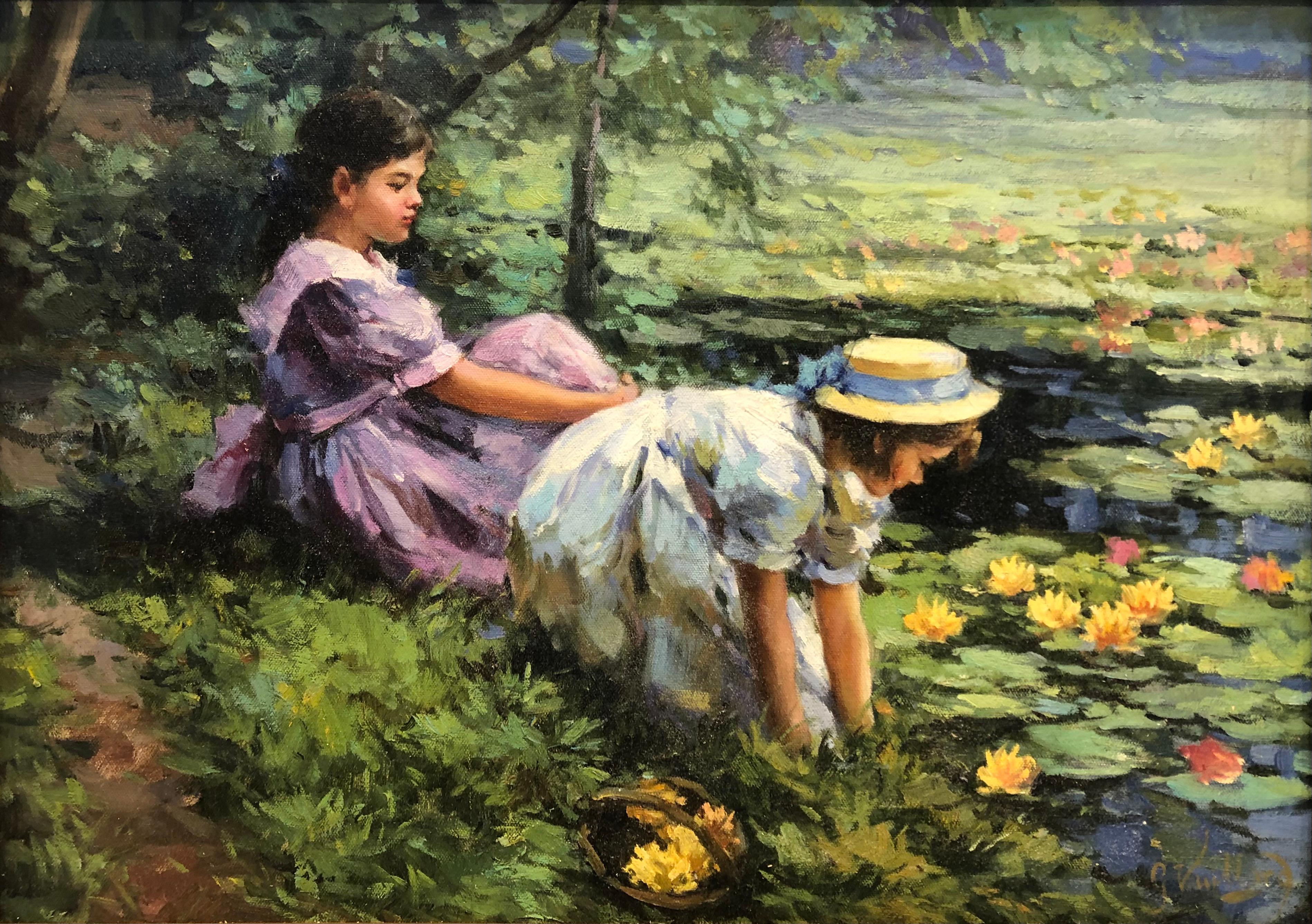Items Similar to Spring
Video Loading
Want more images or videos?
Request additional images or videos from the seller
1 of 10
Constantin KlugeSpring
About the Item
Spring
Constantin Kluge (Russian, Latvian, 1912-2003)
Signed Lower Right
29.5 x 36.5 inches
36.5 x 44 inches framed
He was born in Riga, Latvia, on January 29, 1912 to Russian parents.
His father was a graduate of the Polytechnic Institute of Riga and his mother a Professor of Literature. Kluge's father was drafted into the Czar's army in 1914. Then the chaos of the 1917 Bolshevik Revolution and the ensuing Civil War completely uprooted the family.
They moved frequently, always eastward, arriving in Manchuria in 1920. Here the little boy learned to speak Mandarin. In 1925 the émigré family moved again, this time to the French "concession" of Shanghai, where Kluge would graduate from the French Municipal High School.
By the time he was seventeen, he was a very active member of the Shanghai Art Club. At this period of his life he also took up the violin and cello, and later in Paris gave music lessons to help meet his expenses. Meanwhile, his parents had decided that pure art was not a dependable career, and so in 1931 Kluge left Shanghai for Paris to study architecture. He spent six years at the E'cole des Beaux-Arts and in 1937 graduated with the title of French Government Architect.
The years spent studying and living in the Latin Quarter of Paris had created in Kluge a strong attachment to the characteristic scenes of Paris, and, instead of returning immediately to Shanghai and his family, he stayed on in Paris for six months painting views of Paris in oils, purely to portray and preserve the scenes he so loved. The childhood years spent in the Orient had contributed to his love of painting.
His professor of Chinese had taught him, from the age of ten, a respect for the handling of the brush, and the attitude of the Orientals toward the beauties of nature drew the young artist to the depiction of beauty and away from the vogue for the ugly and sordid in painting. When Kluge returned to China, he practiced his profession of architecture for a time. But when his friends persuaded him to exhibit his paintings, the exhibitions were so successful and aroused such enthusiasm that Kluge felt that painting, his first love, could afford him a livelihood. Kluge spent the years of World War 11 in Shanghai convinced that he avoided trouble with the Japanese occupiers only because of the respect and love the Japanese people have for painting.
In mid-1946 he accepted an architectural post in Hong Kong and continued to paint in his spare time. In March, 1950, amid rumors that the Chinese Communists might invade Hong Kong, Constantin Kluge left Asia for good and returned to his beloved Paris. Already a mature and successful painter by the time he reached Paris, it is not surprising that he won an award and considerable attention at the Paris Salon in 1951. Since that time he was a frequent exhibitor in the Salon shows, which proved to be his gateways to ever increasing public attention. Kluge was a member of the Societe' des Artistes Francais, and his works won prizes at their Salon. In 1961 he was awarded the Medaille d'Argent as well as the special Raymond Perreau prize given by the Taylor Foundation at the Salon.
In 1962 he received the coveted Gold Medal of the Salon. In 1990, Kluge earned one of the most prestigious non-military awards bestowed by the French government: he was named a Chevalier de la Legion d'Honneur by the French Ministry of Culture. In 1991, Kluge was awarded the Grand Medal of the City of Senlis. Completely captivated by the many moods of Paris, Kluge became absorbed in painting this beautiful city. The gaiety and animation of the flower markets; the subtly pensive and poetic quiet areas along the Seine; the special quality of Paris sunshine in early spring; the quaintness yet sophistication of Pairis are wonderfully expressed in his widely varied compositions. His fascination with Paris is contagious and the viewer feels drawn into each Kluge painting. In addition to Paris scenes, Kluge has sought out quiet, picturesque harbor scenes where the colors of water and sails blend to form softly modulated patterns of great beauty and interest. As with his paintings along the Seine, Kluge's handling of water in these harbor scenes is unusually lovely and convincing.
Probably due to his early architectural training, Kluge has in the past been primarily occupied with subjects which include buildings of many types, but pure landscape subjects intrigued him as well. In his country scenes of provincial France, where sunlight and changing atmospheric qualities present a new challenge, Kluge used the same subtlety and sensitive rendering of beauty found in his other work. It is interesting to find this capable painter rounding out his repertoire in such varied fashion. While Kluge continued to paint, he ws also a writer of considerable stature. His autobiography, Constantin Kluge (published in 1987), details his fascinating life and includes many color reproductions of his paintings.
French art critics have declared that Constantin Kluge was a painter of poetic realism. Kluge painted without affectation, in a frank and straightforward style. His firm drawing and well-constructed forms are bathed in an atmosphere of subtle colors. He enjoyed painting and communicated that joy to the beholder.
- Creator:Constantin Kluge (1912 - 2003, French)
- Dimensions:Height: 29.5 in (74.93 cm)Width: 36.5 in (92.71 cm)
- Medium:
- Movement & Style:
- Period:
- Condition:
- Gallery Location:Missouri, MO
- Reference Number:1stDibs: LU747314223872
About the Seller
5.0
Vetted Seller
These experienced sellers undergo a comprehensive evaluation by our team of in-house experts.
Established in 1970
1stDibs seller since 2017
141 sales on 1stDibs
Typical response time: 21 hours
- ShippingRetrieving quote...Ships From: Missouri, MO
- Return PolicyA return for this item may be initiated within 2 days of delivery.
More From This SellerView All
- Central Park AutumnBy Paul CornoyerLocated in Missouri, MOPaul Cornoyer “Central Park Autumn” c. 1910 Oil on Canvas Framed Size: approx 29 x 35 inches Canvas Size: approx 22 x 26.5 inches Provenance: The Artist to Private Collection, St. Louis thence by Descent Conservation report: Excellent condition. On original canvas, not relined. No in-painting. Paul Cornoyer was born in 1864 in St. Louis, Missouri. He studied there at the School of Fine Arts in 1881. His first works were in a Barbizon mode, and his first exhibit was in 1887. In 1889, he went to Paris for further training, studying at the Academie Julien, and returned to St. Louis in 1894. By the early 1890s, his work was more lyrical and Tonal, and he applied this style to subjects such as cityscapes and landscapes. In 1894, he painted a mural depicting the birth of St. Louis for the Planters Hotel in that city. His activities during the next six years were not particularly profitable, however, and the whereabouts of his St. Louis paintings are scarcely known. One exception is the triptych, A View of Saint Louis, with its strong urban realism. It shows the Eads Bridge...Category
1910s American Impressionist Figurative Paintings
MaterialsCanvas, Oil
- Straw FieldsBy Joan ParkerLocated in Missouri, MOJoan Parker (20th C.) "Straw Fields" Oil on Canvas Canvas Size: 10 x 20 inches Framed Size: 21 x 31 inches Joan Parker, is a Plein Air landscape painter and a native of California....Category
21st Century and Contemporary American Impressionist Landscape Paintings
MaterialsCanvas, Oil
- Place De La BastilleBy Édouard Leon CortèsLocated in Missouri, MOEdouard Cortes (French, 1882-1969) Place De La Bastille Signed Lower Left 18 x 22 inches 29 x 33 inches with Frame Cortès was born in Lagny, France on April 26, 1882. During his early lifetime, Paris was the center of the art world. Artist from across the globe traveled there to study and paint it's beautiful countryside and cities; views of Paris, or as it became known 'the City of Lights', were in great demand by both collectors and tourists. Édouard Cortès, along with other artists like Eugene Galien-Laloue (1854-1941), Luigi Loir (1845-1916) and Jean Beraud (1849-1936) answered their call. Specializing in Paris street scenes, each of these artists captured the city during its heyday and continued with these scenes well into the 20th century.Édouard was the son of Antonio Cortès - the Spanish Court painter - who was himself the son of the artisan André Cortès...Category
Early 20th Century Impressionist Figurative Paintings
MaterialsOil, Canvas
- Avenue des Champs-Elysses, ParisBy Antoine BlanchardLocated in Missouri, MOAntoine Blanchard (French 1910-1988) "Avenue des Champs-Elysses, Paris" Oil on Canvas Signed approx 18 x 22 (site) approx 26.5 x 30 (framed) Antoine Blanchard (c.1910-1988) was a prolific and successful Neo-Impressionist painter who specialized in nostalgic scenes of Fin de Siècle Paris. Inspired by the subjects as well as the success of earlier painters of Parisian life like E. Galien Laloue (1854-1941), Edouard Cortès (1882-1969), Jean Béraud (1849-1935) and Luigi Loir (1845-1916), Blanchard painted hundreds of views of the “City of Light.” In the late 1950s, his street scenes were exported to the United States and the United Kingdom, where they were sold briskly to collectors. By the1960s, Blanchard paintings were bringing several hundred dollars in galleries, so while they were not inexpensive, they were affordable to collectors who loved Parisian scenes but who could not afford the works of Cortes or one of the other French painters known for their views of Paris in Belle Époque. Eventually Blanchard’s more delicate, feathery pastel-toned scenes of rain-swept Paris became sought after in their own right and, when he died, he was considered the last of what the dealers described as the École de Paris or “School of Paris” painters. The most salient fact about the life and career of the painter Antoine Blanchard was that he was actually born Marcel Masson, the son of a furniture maker who lived in the scenic Loire Valley, south of Paris, where the French nobility had their chateaus. The date that is usually given for Blanchard’s birth is November 15, 1910. However, there has been some speculation that he was born even later, perhaps in 1918, but some of the facts of his life have always been clouded by early biographies that claimed even earlier dates for his birth, so that he would seem to be seen as a contemporary of the famous Belle Époque painters rather than a post-war interpreter of Paris. Blanchard grew up in the hardscrabble years following the First World War. Because he was artistically talented, he was sent first to the nearby city of Blois, the capital of the Loir-et-Cher Département, for artistic training and then to the École des Beaux-Arts in Rennes, on the Brittany peninsula, where he received a classical art education. By some accounts Blanchard also studied in Paris, where the historic École des Beaux-Arts is located, but the depth of his study and the style of his earliest work will require further research. Marcel Masson was married in 1939, as war clouds gathered on the French horizon. He was drafted for service in the French Army and participated in the short and futile struggle against the invading German Panzers before returning to his family and his art during the Nazi occupation. A daughter, Nicole, was born in 1944 with a second daughter, Eveline, who eventually came to the United States, following in 1946. Masson’s early art career was interrupted, first by World War II and later by the necessity of keeping his father’s workshop running in the years after his death. By the late 1940s, though, Masson returned to his art and moved to Paris in order to further his career. Exactly when Marcel Masson adopted the pseudonym Antoine Blanchard is not known, nor are we aware of his motivations for adopting a nom de plume, but the practice was not unusual for French painters. In most cases a pseudonym was adopted because the artist had contractual obligations with more than one agent or dealer. Another motivation could be to obscure the scope of a sizable artistic production. Dealers in that era also liked to keep an artist under their thumb, so a pseudonym was a way for Blanchard’s dealers to tuck him away, out of the sight of their competitors. Like many painters before him Masson may have initially painted different subjects under different names. Marcel Masson neé Blanchard would have been well aware that the famous and prolific French painter E. Galien Laloue (1854-1941) painted under no less than four names – three pseudonyms in addition to name he was christened with – and so the adoption of another name was probably not seen as a liability to him. However, he apparently never took the step to register his pseudonym, which was possible in France, to legally restrict its use. In any event, by the 1950s Marcel Masson had become “Antoine Blanchard,” a painter of Parisian views. With the aging Edouard Cortès (1882-1969) as a model, Blanchard began to specialize in romanticized scenes of la ville des lumières, or the “City of Light.” However, instead of painting contemporary Paris, the crowded metropolis of his own time, which he may have felt was lacking in romance, he chose to look at the French capital through the rear-view mirror. So Blanchard became known for his depictions of the hurly-burly life of Paris in the Belle Époque. For inspiration, he is said to have collected old sepia-toned postcards of life in La Belle Époque (“The Beautiul Era”), the long period of peace and relative prosperity between the end of the Franco-Prussian War and the horrors of the Paris Commune in 1871 and the start of the mass bloodshed of the First World War in August of 1914. In addition, however, the paintings of Loir, Baraud, Laloue and Cortès could be found and studied in the flea markets of Paris as well as the auctions at the l’Hôtel Drouot. Reminders of the Belle Epoch were thus all around Blanchard, and of course the architecture that he painted had survived the Second World War intact, because Paris was spared bombing or a siege by the allies. Soon he was painting the horse-drawn omnibuses that took turn-of-the-century Parisians on longer trips throughout the city as well as the tradesmen, children and fashionably dressed ladies that populated Baron Haussmann’s Grand Boulevards. Blanchard’s early work was clearly modeled after the paintings of Edouard Cortès, but he was always his own man and never a slavish copyist. These paintings were darker in palette than the later Blanchard paintings most American collectors have become familiar with, and his red and blue tones were often bolder than those of Cortès. He never adopted the heavy “impasto,” the build-up of paint on the highlights of Cortes’ work, leaving that artistic trademark to the master. Blanchard’s brushwork was painterly, but the buildings in the paintings were always well rendered, for he had an excellent command of composition and perspective. By the late 1950s, agents began to purchase Blanchard’s paintings and then to export them to the United States, selling them to commercial galleries in far away Houston, Los Angeles, San Francisco, Chicago and New York. By the early 1960s, his work was already well known enough to be in reproduced by print publishers and the Donald Art Company published a number of popular prints that are now often mistaken for original paintings. By the end of the 1960s, Blanchard had begun to develop his own mature style by employing a lighter, brighter, palette and a deft, almost calligraphic style of brushwork. This helped him step out of Cortès’ shadow and become a sought-after painter in his own right. Blanchard worked through agents, essentially brokers, who purchased his work and created a demand for it in the United States and Canada. By the 1970s Blanchard’s paintings were being sold by galleries across the United States, and the American market absorbed virtually all of his work. In 1969, with the passing of Edouard Cortès, he became the last of the long series of prolific French painters of Parisian life. Blanchard’s later works were usually daylight scenes, with Paris seen awash in rain or with a mantle of soft snow, and so collectors no longer confused him with Cortes, whose Parisian clock seemed to always be set at twilight. These paintings were rendered in softer, pastel tones and he used his brush with a light touch. These qualities gave Blanchard’s work of the 1970s and 1980s a lighter, more decorative appearance. In the late 1970s, the French agent Paul Larde published a lavish book that was claimed to be an authorized biography of Antoine Blanchard by his “exclusive” dealer. Today, this book is almost impossible to find, because it was apparently the subject of a lawsuit in France. Some of the information in the Larde book was contested and found to be inaccurate and so it was withdrawn from publication. One claim that Larde made was that Blanchard’s production was extremely limited. While he was not as prolific as Cortès or Laloue, he was a hard-working painter who managed to supply a long list of galleries with his work. He produced thousands of paintings during his career. When the motivation for a monograph is marketing rather than art history, accuracy and detail can be swept aside by exaggeration, hyperbole and claims of exclusivity that were meant to discourage collectors or galleries from buying Blanchard’s from other representatives. Blanchard’s legitimate paintings were sold by several agents, who dealt directly with the artist, at least one of whom was American, one Austrian and a few French dealers. The details of Antoine Blanchard’s life are not well known because he never sought the limelight. He was content to work in his studio and ship his paintings to his agents who sold them abroad. Eventually both his daughters – Nicole and Evelyn – followed in his footsteps and became painters themselves. Evelyn (1946-2008) was savvy enough to adopt the Blanchard nom de plume, and she began painting street scenes that closely resembled her father’s later work. Antoine Blanchard passed away in 1988, leaving hundreds of paintings of Belle Époque Paris– the Notre Dame Cathedral, the Opera, the Arc de Triomphe and Place Concorde – as his lasting legacy. Notes on the Authentication of Antoine Blanchard’s Paintings: The vast majority of Blanchard’s paintings were smaller works, which were sent to the United States in tubes and stretched and framed by the galleries that sold them. Virtually all of these Blanchards were painted in European centimeter sizes, which convert to 13” x 18” or 18” x 21 1/2?, but on very rare occasions he painted much larger works in American sizes – such as 24” x 36” – on commission for dealers such as Howard Morseburg in Los Angeles or the dapper Wally Findlay, who had a chain of galleries. The first way to assess the authenticity of a Blanchard...Category
Mid-20th Century Impressionist Landscape Paintings
MaterialsCanvas, Oil
- The Avenue Lights (5th Avenue, New York City)By Gerald Harvey JonesLocated in Missouri, MOThe Avenue Lights (5th Avenue, New York City) By. Gerald Harvey Jones (American, 1933-2017) Signed Lower Left 20 x 16 inches without frame 30.5 x 26.5 inches with frame G. Harvey (G...Category
20th Century American Impressionist Figurative Paintings
MaterialsCanvas, Oil
- La Seine, ParisBy Frank Myers BoggsLocated in Missouri, MOLa Seine, Paris, 1897 By Frank M. Boggs (American, 1855-1926) Unframed: 15" x 22" Framed: 23" x 30" Signed and Dated Lower Left Frank Boggs was a master o...Category
Late 19th Century American Impressionist Landscape Paintings
MaterialsCanvas, Oil
You May Also Like
- Venice Landscape Italian Oil on Canvas Painting in Gilt Wood Frame, Belle EpoqueLocated in Firenze, ITThis delightful turn of the century (early 20th century) oil on canvas painting represents an Italian landscape with one of the most famous squares in the world: Piazza San Marco in ...Category
Early 20th Century Impressionist Landscape Paintings
MaterialsCanvas, Oil
- Houses And River-Large Impressionist Landscape Oil on Canvas Signed A.HuntingtonLocated in Coimbra, PT"Houses And River" Signed A. Huntington (English School) Oil on canvas Measures: Canvas - 60x110 cm (Gilt Wood Frame - 76x126 cm) Private collection. FramedCategory
Early 20th Century Impressionist Landscape Paintings
MaterialsCanvas, Oil
- The Twins in the FieldBy James Wells ChampneyLocated in Greenville, DEExcellent example of the artist's work. Overall condition good. Early lining is also good. The sky was possibly repainted (probably by Champney 100+ years ago). Period frame 26 1/2in...Category
Late 19th Century Impressionist Landscape Paintings
MaterialsCanvas, Oil
- Parisian Street SceneBy Luigi CaglianiLocated in Greenville, DELuigi Cagliani (1910-1987) Paris street scene mid 20th century. Signed lower left. In a beautiful 17 x 19.5in hand carved period frame.Category
Mid-20th Century Impressionist Landscape Paintings
MaterialsCanvas, Oil
- Deck of FoxhillLocated in Greenville, DEMarine scene from the deck of a Maine estate (Foxhill). William Beebe considers himself a Creative Realist, using touches of impressionism to go beyond representation. This particula...Category
20th Century American Impressionist Landscape Paintings
MaterialsOil, Canvas
- The Lily PondBy George VuillardLocated in Greenville, DEImpressionist painting by French artist George Vuillard in excellent condition. Painting is on canvas that has been mounted on wood panel. Approx 26 x ...Category
Late 20th Century Impressionist Landscape Paintings
MaterialsCanvas, Oil





